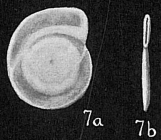Foraminifera taxon details
Planispirinella Wiesner, 1931
112055 (urn:lsid:marinespecies.org:taxname:112055)
accepted
Genus
Hauerina exigua Brady, 1879 accepted as Planispirinella exigua (Brady, 1879) (type by original designation)
marine, brackish, fresh, terrestrial
Wiesner, H. (1931). Die Foraminiferen der deutschen Südpolar Expedition 1901-1903. <em>Deutsche Südpolar-Expedition, Berlin (Zoology).</em> 20: 53-165. [details]
Hayward, B.W.; Le Coze, F.; Vachard, D.; Gross, O. (2024). World Foraminifera Database. Planispirinella Wiesner, 1931. Accessed at: https://www.marinespecies.org/foraminifera/aphia.php?p=taxdetails&id=112055 on 2024-04-19
Date
action
by
2006-09-27 07:06:07Z
changed
Martinez, Olga
original description
Wiesner, H. (1931). Die Foraminiferen der deutschen Südpolar Expedition 1901-1903. <em>Deutsche Südpolar-Expedition, Berlin (Zoology).</em> 20: 53-165. [details]
basis of record Gross, O. (2001). Foraminifera, <B><I>in</I></B>: Costello, M.J. <i>et al.</i> (Ed.) (2001). <i>European register of marine species: a check-list of the marine species in Europe and a bibliography of guides to their identification. Collection Patrimoines Naturels,</i> 50: pp. 60-75 (look up in IMIS) [details]
additional source Neave, Sheffield Airey. (1939-1996). Nomenclator Zoologicus vol. 1-10 Online. <em>[Online Nomenclator Zoologicus at Checklistbank. Ubio link has gone].</em> , available online at https://www.checklistbank.org/dataset/126539/about [details]
additional source Loeblich, A. R.; Tappan, H. (1987). Foraminiferal Genera and their Classification. Van Nostrand Reinhold Company, New York. 970pp., available online at https://books.google.pt/books?id=n_BqCQAAQBAJ [details] Available for editors [request]
[request]
basis of record Gross, O. (2001). Foraminifera, <B><I>in</I></B>: Costello, M.J. <i>et al.</i> (Ed.) (2001). <i>European register of marine species: a check-list of the marine species in Europe and a bibliography of guides to their identification. Collection Patrimoines Naturels,</i> 50: pp. 60-75 (look up in IMIS) [details]
additional source Neave, Sheffield Airey. (1939-1996). Nomenclator Zoologicus vol. 1-10 Online. <em>[Online Nomenclator Zoologicus at Checklistbank. Ubio link has gone].</em> , available online at https://www.checklistbank.org/dataset/126539/about [details]
additional source Loeblich, A. R.; Tappan, H. (1987). Foraminiferal Genera and their Classification. Van Nostrand Reinhold Company, New York. 970pp., available online at https://books.google.pt/books?id=n_BqCQAAQBAJ [details] Available for editors
From editor or global species database
Diagnosis Test discoidal, flattened, globular proloculus followed by planispirally coiled narrow second chamber, later with about three chambers per whorl, septa oblique, very thin, external sutures obscured by the thickened wall; wall calcareous, imperforate, porcelaneous, thick, as additional lamellae cover the central part of the test with each successive whorl to leave only a much restricted chamber lumen; aperture a high slitlike opening in the face of the final chamber. Holocene; Pacific; Australia. (Loeblich & Tappan, 1987, Foraminiferal Genera and Their Classification) [details]


